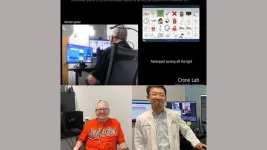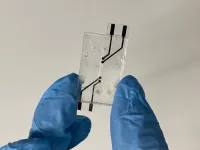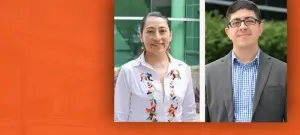(Press-News.org) It’s the day after the Baltimore Orioles clinched the American League East Championship with their 100th win of the season, and lifelong fan Tim Evans is showing his pride on his sleeve.
“It’s so great,” Evans, 62, says with a huge smile, wearing his orange O’s jersey.
The last time the Orioles won the AL East was in 2014, the same year Evans was diagnosed with amyotrophic lateral sclerosis (ALS), a progressive nervous system disease that causes muscle weakness and loss of motor and speech functions. Evans currently has severe speech and swallowing problems. He can talk slowly, but it’s hard for most people to understand him.
However, Evans is getting a sense of control back, thanks to a brain-computer interface (BCI) — a direct communication pathway between the brain and external smart devices. The BCI device, called Cortical Communication (CortiCom), is surgically implanted on the surface of the brain areas responsible for speech and upper limb function. Evans is participating in a clinical trial at Johns Hopkins Medicine, in collaboration with the Johns Hopkins University Applied Physics Laboratory, that is looking at a series of studies using the device in patients with severe speech and movement difficulties to regain some of the abilities lost due to neurological diseases.
By using the BCI with a special computer algorithm trained to translate his brain signals into computer commands, Evans is able to freely and reliably use a set of six basic commands (up, down, left, right, enter and back) to navigate among options on a communication board and to control smart devices like room lights and streaming TV applications.
The results, published Oct. 25 in Advanced Science, show a sustained accuracy of 90% over a three-month period without requiring the BCI algorithm to be retrained or recalibrated.
“While past studies on speech BCI have focused on communication, our study addressed the need to control smart devices directly,” says Nathan Crone, M.D., professor of neurology at Johns Hopkins Medicine, senior author of the study, and principal investigator of the clinical trial. “The BCI accurately recognized a small set of simple commands, allowing Tim to navigate a communication board and control household devices without needing a language model to fix errors.”
“It’s wonderful. I can turn on the TV and turn off the lights without getting up,” Evans says. “I can see the possibilities for other patients.”
HOW IT WORKS
In the summer of 2022, William Anderson, M.D., Ph.D., M.A., professor of neurosurgery, and Chad Gordon, D.O., professor of plastic and reconstructive surgery, both at the Johns Hopkins University School of Medicine, placed two electrocorticographic (ECoG) grids on the surface of Evans’ brain. An ECoG grid is a thin sheet of electrodes (tiny sensors) with a footprint the size of a large postage stamp placed on a person’s brain to record the electrical signals produced by thousands of brain cells (neurons).
Evans worked with the research team for several weeks to train the BCI to recognize his unique brain signals, repeating each of the six commands aloud as they appeared on a screen. Once the BCI’s deep-learning algorithm was trained, Evans was asked to issue the same verbal commands to control a communication board in real time, usually for about five minutes every day for the next three months.
“While Tim’s speech was difficult for most human listeners to understand, the BCI was able to accurately translate his brain activity into computer commands, allowing him to navigate to and select items on a communication board at his own pace,” says Shiyu Luo, graduate student in biomedical engineering at The Johns Hopkins University and first author of the paper. “In addition to expressing how he was feeling or what he wanted, Tim was able to use the BCI to turn a light on and off, and to select videos to watch on YouTube.”
Throughout testing, researchers discovered that using signals from both motor and sensory areas of the brain produced the best results. Brain areas related to the movement of the lips, tongue and jaw had the most influence on the BCI’s performance, and stayed consistent over three months of the study, playing a crucial role in making the BCI work well and reliably, says Luo.
DIFFERENT APPROACH
Crone says that, unlike many other BCI studies, this approach used electrodes that do not penetrate the brain, allowing the team to record large populations of neurons from the surface of the brain instead of individual neurons.
“These population responses appear to be more stable over time,” Crone says. “They don’t change from day to day as much, so the BCI algorithm we used for controlling the computer interface did not require recalibration or retraining for at least three months.”
Crone says not having to retrain the BCI algorithm means this approach potentially allows participants the freedom to use the BCI whenever and wherever they want without ongoing researcher intervention. In the future, hopefully this means a participant with severe paralysis can start their day by turning on the lights and catching up with the news on TV using only their brain signals.
“What’s amazing about our study is that the accuracy didn’t change over time, it worked just as well on Day 1 as it did on Day 90,” Crone says. “Our results may be the first steps in realizing the potential for independent home use of speech BCIs by people living with severe paralysis.”
WHAT’S NEXT
One limitation of the study was the limited vocabulary used for decoding speech. Crone says that although the six commands they adopted were both intuitive and sufficient for controlling grid-based applications, a more comprehensive vocabulary may reduce the time needed to perform a broader range of tasks.
Currently, Crone and his team are working with Evans on a series of other studies that expand the vocabulary the BCI can pick up from his brain signals. They are also actively recruiting patients for clinical trials investigating BCI systems for those with movement and communication impairments.
“It’s a very exciting time in the field of brain-computer interfaces because there are several companies investing in this technology,” says Crone. “For those who have lost their ability to communicate due to a variety of neurological conditions, there’s a lot of hope to preserve or regain their ability to communicate with family and friends. But there’s still a lot more work to be done to bring this to all patients who could use this technology.”
As for Evans, Crone says they are working on a plan to move the BCI equipment to his home, pending approval from the Food and Drug Administration, meaning Evans may soon have the ability to use the BCI on his own to watch the Orioles on TV without the help of others.
“My son has a bad habit of leaving the TV remote in the other room,” Evans jokes.
For more information on the CortiCom study, clcik here.
Additional study authors include Miguel Angrick, Christopher Coogan, Daniel Candrea, Kimberly Wyse-Sookoo, Samyak Shah, Qinwan Rabbani, Alexander Weiss, William Anderson, Donna Tippett, Nicholas Maragakis, Lora Clawson and Hynek Hermansky from the Johns Hopkins University School of Medicine; Griffin Milsap, Brock Wester, Francesco Tenore and Matthew Fifer from the Johns Hopkins University Applied Physics Laboratory; and Nick Ramsey and Mariska Vansteensel from University Medical Center Utrecht Brain Center in the Netherlands.
The study was funded by the National Institutes of Health's National Institute of Neurological Disorders and Stroke.
All authors report no conflict of interest.
END
Brain-computer interface restores control of home devices for Johns Hopkins patient with ALS
The brain-implanted device was used to reliably control a communication board and smart devices like lights and television for three months without recalibration
2023-10-25
ELSE PRESS RELEASES FROM THIS DATE:
Screen printed electrodes for measuring endothelial barrier integrity
2023-10-25
(LOS ANGELES) – October 25, 2023 - The Terasaki Institute for Biomedical Innovation (TIBI) has developed a novel organ-on-a-chip device for measuring electrical resistance across endothelial barriers. This chip had carbon-based, screen-printed electrodes incorporated into a multi-layered, microfluidic chip fabricated by a simple and cost-effective method.
Endothelial cells line blood and lymph vessels of the body and form a barrier layer which controls the flow of fluid and substances to and from the vessels and surrounding tissues. Study of the crucial roles ...
UTSA researchers receive $3.6 million National Science Foundation grant to break down language barriers in engineering education
2023-10-25
(SAN ANTONIO, OCTOBER 25, 2023)—The National Science Foundation (NSF) has awarded a five-year, $3.6 million grant to two professors at The University of Texas at San Antonio (UTSA) to develop a better way to communicate engineering acumen to diverse engineering classes.
Joel Alejandro Mejia and M. Sidury Christiansen are collaborating on an ethnographic project, “Rhetorical Engineering Education to Support Proactive Equity Teaching and Outcomes (RESPETO).” The project will include a handbook of recommended pedagogical approaches to address exclusionary language and linguistic practices in engineering classes.
The project was motivated by several factors. Among them, ...
Marketing research is too narrow: Hw the field must change to keep producing relevant, timely knowledge
2023-10-25
Researchers from TU Dortmund University and RWTH Aachen University published a new Journal of Marketing article that examines how specific types of marketing knowledge contributions have developed over the past few decades and suggests ways to move the field toward “big picture” theories that will have greater impact.
The study, forthcoming in the Journal of Marketing, is titled “Conceptual Contributions in Marketing Scholarship: Patterns, Mechanisms, and Rebalancing Options” and is authored by Bastian Kindermann, ...
Sunflower extract fights fungi to keep blueberries fresh
2023-10-25
Opening a clamshell of berries and seeing them coated in fuzzy mold is a downer. And it’s no small problem. Gray mold and other fungi, which cause fruit to rot, lead to significant economic losses and food waste. Now, researchers report in ACS’ Journal of Agricultural and Food Chemistry that compounds from sunflower crop waste prevented rotting in blueberries. They suggest the food industry could use these natural compounds to protect against postharvest diseases.
Sunflowers are cultivated around the world for their seeds and oil, but the flower stems — known as receptacles — are generally considered to be a waste product. Noting that this crop is particularly ...
Global platform study presents results to guide care of severely ill patients with COVID-19 using routinely available drugs
2023-10-25
The Global Coalition for Adaptive Research (GCAR) in collaboration with the University of Pittsburgh and UPMC, on behalf of the REMAP-CAP Investigator Network, announce clinical trial results examining the use of vitamin C and simvastatin to treat severely ill patients with COVID-19.
Published today in JAMA and NEJM, and presented at the European Society of Intensive Care Medicine in Milan, the studies are part of the ongoing Randomized Embedded Multifactorial Adaptive Platform for Community Acquired Pneumonia (REMAP-CAP) trial.
Simvastatin, a widely available and inexpensive drug that is included on the WHO list of essential medicines, ...
Intravenous Vitamin C for patients hospitalized with COVID-19
2023-10-25
About The Study: In hospitalized patients with COVID-19, vitamin C had low probability of improving the primary composite outcome of organ support–free days and hospital survival in two harmonized randomized clinical trials.
Authors: Neill K. J. Adhikari, M.D.C.M., M.Sc., of the Sunnybrook Health Sciences Centre in Toronto, and Francois Lamontagne, M.D., M.Sc., of the Universite de Sherbrooke in Sherbrooke, Canada, are the corresponding authors.
To access the embargoed study: ...
Sigh ventilation in patients with trauma
2023-10-25
About The Study: In a randomized clinical trial including 524 trauma patients receiving mechanical ventilation with risk factors for developing acute respiratory distress syndrome, the addition of sigh breaths did not significantly increase ventilator-free days. Prespecified secondary outcome data suggest that sighs are well-tolerated and may improve clinical outcomes.
Authors: Richard K. Albert, M.D., of the University of Colorado, Denver, is the corresponding author.
To access the embargoed study: Visit our For The Media website at this link https://media.jamanetwork.com/
(doi:10.1001/jama.2023.21739)
Editor’s Note: Please see the ...
Landiolol and organ failure in patients with septic shock
2023-10-25
About The Study: The results of this randomized clinical trial involving 126 patients do not support the use of the very short-acting beta-blocker landiolol for managing patients with tachycardia treated with norepinephrine for established septic shock.
Authors: Tony Whitehouse, M.D., of Queen Elizabeth Hospital in Birmingham, United Kingdom, is the corresponding author.
To access the embargoed study: Visit our For The Media website at this link https://media.jamanetwork.com/
(doi:10.1001/jama.2023.20134)
Editor’s Note: Please ...
Convalescent plasma reduces mortality by 10% in COVID-19 patients in acute respiratory distress and on artificial respiratory assistance
2023-10-25
This is the conclusion of a multicentre study conducted by the University Hospital of Liège (CHU of Liège) in collaboration with 17 hospital intensive care departments in Belgium during the Covid-19 phases between October 2020 and March 2022.
This is the first study to look specifically at the effect of administering convalescent plasma to these patients whose vital prognosis is severely compromised. It confirms the value of this method for inducing passive immunisation in these patients.
The results are published in the leading medical journal The New England Journal of Medicine.
In a study published in The New ...
The changing face of gun ownership in the United States
2023-10-25
Learning how to shoot a handgun at a Las Vegas gun convention had never been on Jennifer Hubbert’s bucket list. But last fall, the professor of anthropology and Asian studies found herself doing just that. “Given my research, it felt like something I needed to do,” she says.
Hubbert is currently exploring a novel question regarding gun culture in the United States: “What does it mean to be a liberal gun owner?” The National Endowment for the Humanities (NEH) has recently awarded Hubbert with a grant to support her research and book project: Gun Culture 4.0: Understanding the New Demographics of ...
LAST 30 PRESS RELEASES:
Why nail-biting, procrastination and other self-sabotaging behaviors are rooted in survival instincts
Regional variations in mechanical properties of porcine leptomeninges
Artificial empathy in therapy and healthcare: advancements in interpersonal interaction technologies
Why some brains switch gears more efficiently than others
UVA’s Jundong Li wins ICDM’S 2025 Tao Li Award for data mining, machine learning
UVA’s low-power, high-performance computer power player Mircea Stan earns National Academy of Inventors fellowship
Not playing by the rules: USU researcher explores filamentous algae dynamics in rivers
Do our body clocks influence our risk of dementia?
Anthropologists offer new evidence of bipedalism in long-debated fossil discovery
Safer receipt paper from wood
Dosage-sensitive genes suggest no whole-genome duplications in ancestral angiosperm
First ancient human herpesvirus genomes document their deep history with humans
Why Some Bacteria Survive Antibiotics and How to Stop Them - New study reveals that bacteria can survive antibiotic treatment through two fundamentally different “shutdown modes”
UCLA study links scar healing to dangerous placenta condition
CHANGE-seq-BE finds off-target changes in the genome from base editors
The Journal of Nuclear Medicine Ahead-of-Print Tip Sheet: January 2, 2026
Delayed or absent first dose of measles, mumps, and rubella vaccination
Trends in US preterm birth rates by household income and race and ethnicity
Study identifies potential biomarker linked to progression and brain inflammation in multiple sclerosis
Many mothers in Norway do not show up for postnatal check-ups
Researchers want to find out why quick clay is so unstable
Superradiant spins show teamwork at the quantum scale
Cleveland Clinic Research links tumor bacteria to immunotherapy resistance in head and neck cancer
First Editorial of 2026: Resisting AI slop
Joint ground- and space-based observations reveal Saturn-mass rogue planet
Inheritable genetic variant offers protection against blood cancer risk and progression
Pigs settled Pacific islands alongside early human voyagers
A Coral reef’s daily pulse reshapes microbes in surrounding waters
EAST Tokamak experiments exceed plasma density limit, offering new approach to fusion ignition
Groundbreaking discovery reveals Africa’s oldest cremation pyre and complex ritual practices
[Press-News.org] Brain-computer interface restores control of home devices for Johns Hopkins patient with ALSThe brain-implanted device was used to reliably control a communication board and smart devices like lights and television for three months without recalibration



